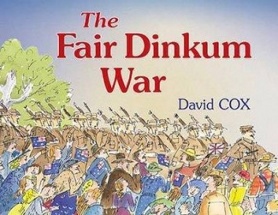The fair dinkum war by David Cox

Allen & Unwin, 2013. ISBN 9781743310625.
(Age: 5+) Highly recommended. During World War two, David Cox was
only a young boy and this title tells of his experiences during the
war. Having moved to the city at the end of Grade One, the author
begins by recounting a number of everyday events which made up his
life through to the end of Grade Five. After sharing the experiences
from the daily lives of many country children, he details the ways
in which things changed when the American army rolled into town.
Children began to play at being soldiers and adults discussed their
fears with other adults diligently keeping their concerns from the
youngsters. Despite this, air raid shelters, trenches, black outs
and the Austerity Program became part of their lives. He describes
the changes which occurred as a result... cars became less utilised
as people reverted to riding bicycles or walking... and extended family
gatherings saw many of their members arriving in the uniforms
of the armed forces. Relationships were formed between the
townspeople, the 'Yanks' and the Javanese soldiers. Although many
families survived with absent husbands and fathers, Cox shows a
positive spirit was nonetheless present amongst the people and was
finally rewarded as peace was declared.
With the National Curriculum bringing about a major focus on
Australian history, there seems to be a rush in producing picture
books to match the various strands. Cox has done so brilliantly with
the release of this and his previous title, The road to Goonong.
For younger children, this will be helpful in showing the
differences between how they themselves live compared to the lives
of their grandparents and great grandparents. Older children
could look more at the timelines shown in this book and focus on the
events of the war as they match those shown in the book. Themes of
perspective (adults, children, 'Yanks', Javanese etc.) resilience,
positivity, building relationships and caring for others from
different backgrounds are all part of this title and could be
further teased out with students. With Cox's sensitive approach in
the text and his cartoon style illustrations (which bear
similarities to those of Quentin Blake) and the use of gentle, warm
colours, this is a title relevant to children of almost any age.
Jo Schenkel